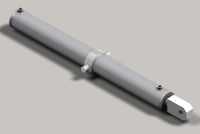When it comes to designing and engineering hydraulic systems, precision is everything. Recent technological developments have seen an increase in the use of 3D modelling to design systems and parts for a range of uses, including design, architecture, medical equipment and hydraulic engineering.
What is 3D modelling?
3D modelling is an alternative to more traditional 2D design methods. Whereas 2D design creates a flat image of a device, 3D modelling uses computer graphics to create a fully three-dimensional image that can be viewed from any angle.
In hydraulic engineering, 3D modelling can be used to design complex products like hydraulic manifolds, hydraulic cylinders and even complete arrangements of complex hydraulic system designs.
What are the benefits of 3D modelling?
With hydraulic systems becoming ever more complex, there is a need for advanced design solutions, which can create accurate models while still being cost effective. This is where 3D modelling has many benefits over 2D design. Here are a few of them:
- Time saving. Because 3D modelling allows you to create a replica of a part or an entire system, you can diagnose many potential problems before the manufacturing stage. Instead of wasting time producing something that doesn’t work, you can proceed to the manufacturing stage confident that the finished product will work effectively without having to redesign anything.
- Cost saving. 3D modelling allows you not only to design but also to test equipment and systems before they are built. This reduces the chance of mistakes costing money, or the finished product not living up to expectations.
- Efficient. 3D software can help engineers work more efficiently than when using 2D techniques.
- Precise. 3D modelling is more precise than 2D modelling and each separate component can be analysed individually. This helps ensure all components are dimensioned correctly for the manufacturer, from individual components to the complete assembly, which is essential when dealing with precision systems and components.
3D modelling techniques are used by many large and small organisations to help create complex structures while saving time and money. With many benefits including precision, efficiency and a reduction in mistakes, 3D modelling is a far superior technology to 2D modelling, and is well worth considering in the design and engineering of a hydraulic system.

